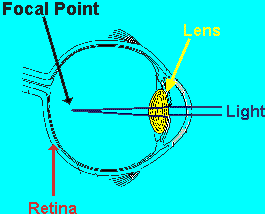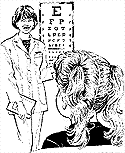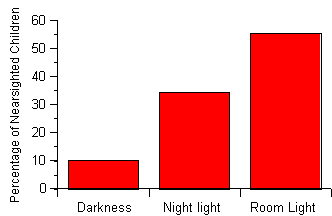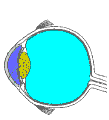 Many concerned parents use night lights to
comfort their children. Are these parents increasing the chance that
their children will become nearsighted? That is what new research from
the University of Pennsylvania seems to suggest. This
research has made news headlines around the world and has worried many
parents. Many concerned parents use night lights to
comfort their children. Are these parents increasing the chance that
their children will become nearsighted? That is what new research from
the University of Pennsylvania seems to suggest. This
research has made news headlines around the world and has worried many
parents.
Nearsightedness, also called myopia, occurs when an image is focused in
front of the retina. A common cause of myopia is a long eyeball.
| Normal Eye | Nearsighted
Eye |
 |  |

 Scientists noticed that light affects eyeball growth in chicks. They
decided to investigate the effects of early light exposure on vision in
people. Researchers in the Department of Ophthalmology at the University
of Pennsylvania tested the vision of 479 children between the ages of 2
and 16 years old. The parents of these children were asked the following
questions about the lighting conditions in the rooms of their children
when the children were younger than 2 years old:
Scientists noticed that light affects eyeball growth in chicks. They
decided to investigate the effects of early light exposure on vision in
people. Researchers in the Department of Ophthalmology at the University
of Pennsylvania tested the vision of 479 children between the ages of 2
and 16 years old. The parents of these children were asked the following
questions about the lighting conditions in the rooms of their children
when the children were younger than 2 years old:
- Did your child sleep in darkness?
- Did your child sleep with a night light on?
- Did your child sleep with a room light on?
| Only 10% of the
children who slept in darkness were found
to be nearsighted. However, 34% of the children who slept with a night
light and 55% of the children who slept with a room light became
nearsighted. (See the graph on the right.)
The authors of this study concluded that light exposure during sleep in
the first two years of life is strongly correlated to nearsightedness.
Note the word correlated. This study has
NOT proved that night lights CAUSE nearsightedness. Rather, this
study found that the use of night lights and nearsightedness are related.
This is an important difference. There may be other reasons why the
children became nearsighted. For example, maybe parents who use night
lights with their children are themselves more likely to be nearsighted.
Therefore, these parents would pass down the genes for nearsightedness to
their children. If this was the case, using night lights would have
nothing to do with the development of nearsightedness. | 
(Data from Quinn et al.,
1999) |
 Additional research is definitely needed. The study
from the University of Pennsylvania used a questionnaire to collect
information. Data from questionnaires are sometimes difficult to
interpret. People who answer questionnaires may try to please researchers
with answers they think are wanted and other people may have trouble
remembering what happened many years in the past. These factors may cloud
the interpretation of the data. Additional research is definitely needed. The study
from the University of Pennsylvania used a questionnaire to collect
information. Data from questionnaires are sometimes difficult to
interpret. People who answer questionnaires may try to please researchers
with answers they think are wanted and other people may have trouble
remembering what happened many years in the past. These factors may cloud
the interpretation of the data.
 Nevertheless, the authors of this study state:
Nevertheless, the authors of this study state:
- "Despite these qualifications, it seems prudent that infants and
young children sleep at night without artificial lighting in the bedroom,
while the present findings are evaluated more
comprehensively."
Clearly, more research is necessary to answer many questions raised by
this study:
- Does early exposure to light at night cause nearsightedness?
- How much light is necessary to cause nearsightedness?
- Do all forms of light (e.g., fluorescent, incandescent, red)
contribute to nearsightedness?
- By what mechanism does light cause nearsightedness?
- What is the role of heredity in nearsightedness?
Answers to these question are especially important when childrens'
eyesight is concerned. |




 Many concerned parents use night lights to
comfort their children. Are these parents increasing the chance that
their children will become nearsighted? That is what new research from
the University of Pennsylvania seems to suggest. This
research has made news headlines around the world and has worried many
parents.
Many concerned parents use night lights to
comfort their children. Are these parents increasing the chance that
their children will become nearsighted? That is what new research from
the University of Pennsylvania seems to suggest. This
research has made news headlines around the world and has worried many
parents.



![[email]](./gif/menue.gif)

